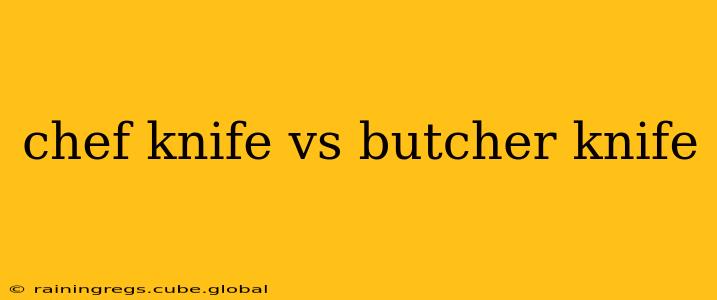Choosing between a chef's knife and a butcher knife can feel overwhelming, especially for home cooks. Both are essential tools, but their distinct designs cater to different tasks. This comprehensive guide will dissect the key differences, helping you decide which knife (or both!) deserves a place in your kitchen arsenal.
What is a Chef's Knife?
The chef's knife, often hailed as the workhorse of the kitchen, is a versatile tool designed for a wide range of tasks. Its curved blade, typically 8-12 inches long, allows for rocking motions ideal for chopping, dicing, mincing, and slicing. Its versatility makes it a staple in most kitchens, capable of handling everything from vegetables and fruits to proteins.
What is a Butcher Knife?
The butcher knife, also known as a butcher's cleaver, is a heavier, more robust knife designed primarily for breaking down large cuts of meat. Its blade is typically longer and straighter than a chef's knife, ranging from 6 to 15 inches. The blade's weight and strength make it ideal for chopping through bone and cartilage with ease.
Chef Knife vs. Butcher Knife: Key Differences
| Feature | Chef's Knife | Butcher Knife |
|---|---|---|
| Blade Shape | Curved | Straight or slightly curved |
| Blade Length | 8-12 inches | 6-15 inches |
| Weight | Lighter | Heavier |
| Primary Use | Chopping, dicing, mincing, slicing | Breaking down large cuts of meat, bone-in cuts |
| Versatility | High | Lower |
Which Knife Should I Choose?
The "best" knife depends entirely on your needs and cooking style.
-
Choose a chef's knife if: You primarily prepare vegetables, fruits, and smaller cuts of meat. You value versatility and want one knife that can handle a variety of tasks. It's a great all-around choice for most home cooks.
-
Choose a butcher knife if: You frequently work with large cuts of meat, including bone-in cuts. You need a robust knife capable of cleanly severing bone and cartilage. This knife is invaluable for breaking down whole chickens, roasts, or larger cuts for stews.
What are the pros and cons of each knife?
Chef's Knife:
Pros: Versatile, excellent for a wide range of chopping and slicing tasks, relatively lightweight and easy to maneuver.
Cons: Not ideal for breaking down bone-in meats, can be less effective on very tough cuts.
Butcher Knife:
Pros: Powerful for cutting through bone, ideal for breaking down large cuts of meat, heavy-duty construction.
Cons: Less versatile than a chef's knife, can be cumbersome for finer chopping tasks, often heavier and less maneuverable.
Can I use a butcher knife for everything a chef's knife does?
While you could use a butcher knife for some tasks a chef's knife handles, it's not ideal. The weight and length make precise dicing and mincing difficult. It's like using a sledgehammer to drive a nail; it might work, but it's inefficient and could damage the material.
Do I need both a chef's knife and a butcher knife?
For the average home cook, a chef's knife is usually sufficient. However, if you frequently prepare large cuts of meat or enjoy butchering your own game, a butcher knife is a worthwhile investment. Ultimately, the decision depends on your individual cooking habits and needs.
How do I choose the right size?
Consider the size of the ingredients you most frequently prepare. For a chef's knife, an 8-inch blade is generally versatile enough for most home cooks, while a 10-inch blade offers increased reach and cutting power. Butcher knives range from 6 to 15 inches; choose a size that's comfortable to handle and appropriate for the size of the meat cuts you'll be working with.
This in-depth comparison should equip you to make an informed decision on whether a chef's knife, a butcher knife, or both are right for your kitchen. Remember, the perfect knife is the one that feels most comfortable and effective in your hands.
